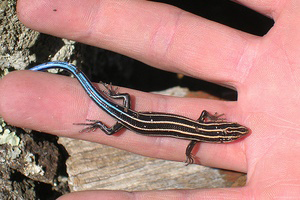As is true of other skinks, the tail of this species is readily detached if the skink is attacked. A detached tail initially wiggles vigorously and may attract the attention of a would-be predator as the lizard escapes. Later, if the tail was not eaten by the predator, the skink may return to the site, find its detached tail using chemical cues, and eat it.
Photo Credit: Taryn via Wikipedia Commons
Plestiodon fasciatus
Common Name: five-lined skink
Other Common Names: common five-lined skink
Other Scientific Names: Eumeces fasciatus
Animal Guild: Reptile
Class > Order > Family: Reptilia > Squamata > Scincidae
What does the species look like?
The scales on the back are smooth and shiny. The middle of the underside of the tail has a row of enlarged scales. Coloration varies with age. Adult males are almost uniformly brown or olive and may have "faded" light stripes; the tail is gray and the jaws are orange-red during the breeding season. Adult females have a gray tail, and the back has five white or yellowish stripes on a dark background. Hatchlings are black with five white or yellowish stripes on the back and sides; the tail is bright blue. Maximum snout-vent length is about 3.4 inches (8.6 cm).
Where is the species found?
States & Provinces
AL, AR, CT, DC, DE, FL, GA, IA, IL, IN, KS, KY, LA, MA, MD, MI, MN, MO, MS, NC, NE, NJ, NY, OH, OK, ON, PA, SC, SD, TN, TX, VA, VT, WI, WV
Distribution
Range extends from western New England and southern Ontario to Minnesota, and south through eastern Kansas and eastern Oklahoma to eastern Texas, the Gulf Coast, and northern peninsular Florida.
Five-lined skinks inhabit wooded areas (especially hardwoods) of many kinds, especially those that are humid, well-drained, supply abundant cover (ledge crevices, rocks, logs, stumps, leaf litter), and have a patchy canopy; they also occupy seasonally flooded lowlands in some areas. Most activity occurs on the ground, but these lizards also climb trees and are distinctly arboreal in Texas.
General Phenology and Life History
Generally secretive, five-lined skinks spend much time under cover. Activity occurs from April to October in the north and over a longer period in the south. Courtship and mating occur in spring. Clutches of 4-14 eggs are laid mostly in May-June, in or under rotting logs, stumps, or humus, or under rocks. The female attends the eggs during incubation. Eggs hatch in 4-7 weeks (mid-July to mid-August in South Carolina). Multiple and communal nests are common in some areas.
Which phenophases should I observe?
Do you see/hear...?
Activity
Individuals on land More...
For abundance, enter the number of individual animals observed in this phenophase.
Feeding For abundance, enter the number of individual animals observed in this phenophase.
Development
Young individuals For abundance, enter the number of individual animals observed in this phenophase.
Dead individuals For abundance, enter the number of individual animals observed in this phenophase.
What do these phenophases look like?
There is currently no photoguide available for this species. If you'd like help us create one, use the guidance document and species template provided here . Then send it via email to education@usanpn.org when it is complete.
